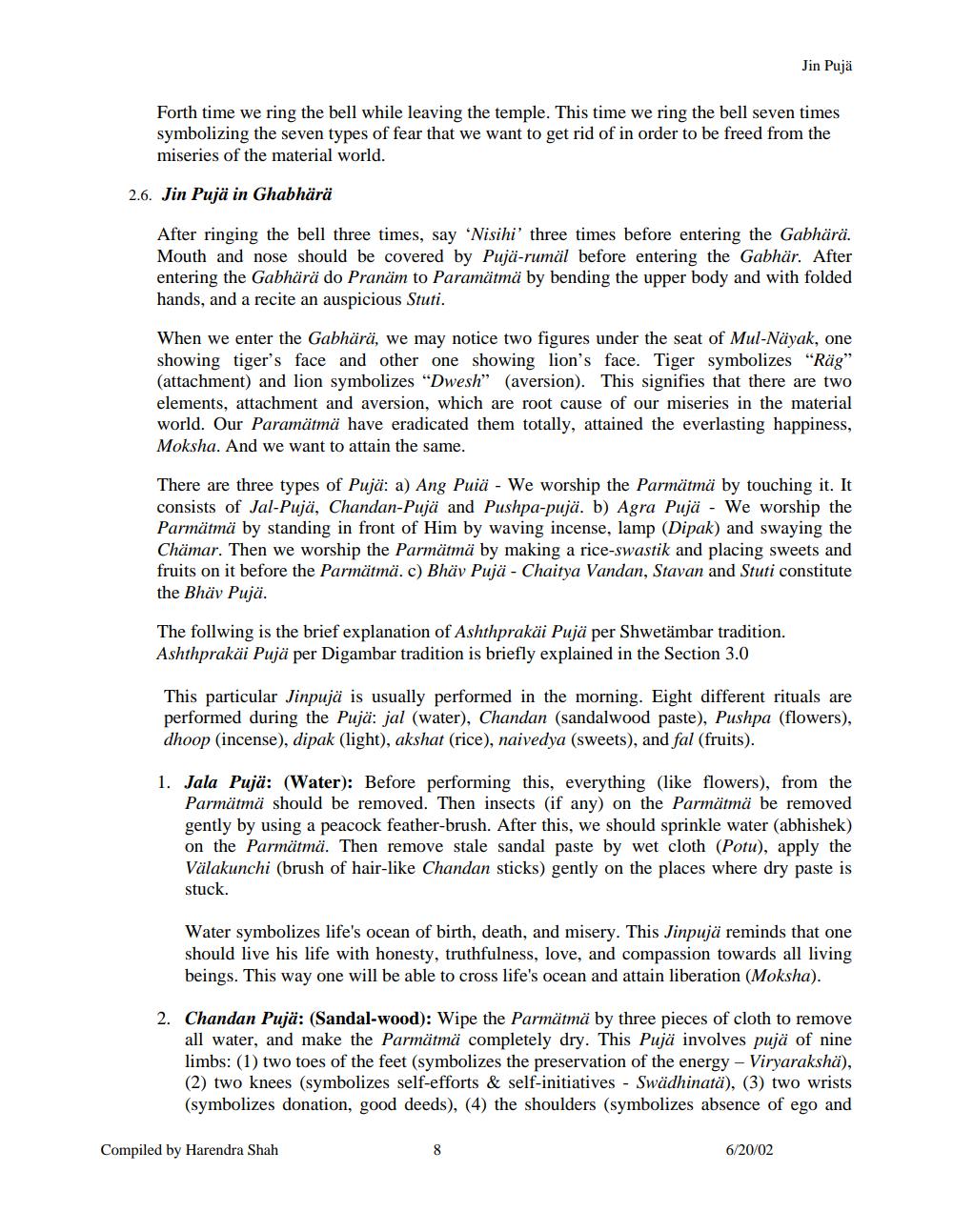Book Title: Jin puja Author(s): Harendra Shah Publisher: USA Jain Center Northern Calfornia View full book textPage 8
________________ Jin Pujä Forth time we ring the bell while leaving the temple. This time we ring the bell seven times symbolizing the seven types of fear that we want to get rid of in order to be freed from the miseries of the material world. 2.6. Jin Puja in Ghabhärä After ringing the bell three times, say "Nisihi' three times before entering the Gabhärä. Mouth and nose should be covered by Pujä-rumäl before entering the Gabhär. After entering the Gabhärä do Pranäm to Paramätmä by bending the upper body and with folded hands, and a recite an auspicious Stuti. When we enter the Gabhärä, we may notice two figures under the seat of Mul-Näyak, one showing tiger's face and other one showing lion's face. Tiger symbolizes "Räg" (attachment) and lion symbolizes "Dwesh" (aversion). This signifies that there are two elements, attachment and aversion, which are root cause of our miseries in the material world. Our Paramätmä have eradicated them totally, attained the everlasting happiness, Moksha. And we want to attain the same. There are three types of Pujä: a) Ang Puiä - We worship the Parmätmä by touching it. It consists of Jal-Pujä, Chandan-Pujä and Pushpa-pujä. b) Agra Pujä - We worship the Parmätmä by standing in front of Him by waving incense, lamp (Dipak) and swaying the Chämar. Then we worship the Parmätmä by making a rice-swastik and placing sweets and fruits on it before the Parmätmä. c) Bhäv Puja - Chaitya Vandan, Stavan and Stuti constitute the Bhäv Pujä. The follwing is the brief explanation of Ashthprakäi Pujä per Shwetämbar tradition. Ashthprakäi Pujä per Digambar tradition is briefly explained in the Section 3.0 This particular Jinpujä is usually performed in the morning. Eight different rituals are performed during the Pujä: jal (water), Chandan (sandalwood paste), Pushpa (flowers), dhoop (incense), dipak (light), akshat (rice), naivedya (sweets), and fal (fruits). 1. Jala Pujä: (Water): Before performing this, everything like flowers), from the Parmätmä should be removed. Then insects (if any) on the Parmätmä be removed gently by using a peacock feather-brush. After this, we should sprinkle water (abhishek) on the Parmätmä. Then remove stale sandal paste by wet cloth (Potu), apply the Välakunchi (brush of hair-like Chandan sticks) gently on the places where dry paste is stuck. Chandale sandal this, we shon, the Water symbolizes life's ocean of birth, death, and misery. This Jinpujä reminds that one should live his life with honesty, truthfulness, love, and compassion towards all living beings. This way one will be able to cross life's ocean and attain liberation (Moksha). 2. Chandan Pujä: (Sandal-wood): Wipe the Parmätmä by three pieces of cloth to remove all water, and make the Parmätmä сompletely dry. This Pujä involves pujä of nine limbs: (1) two toes of the feet (symbolizes the preservation of the energy - Viryarakshä), (2) two knees (symbolizes self-efforts & self-initiatives - Swädhinatä), (3) two wrists (symbolizes donation, good deeds), (4) the shoulders (symbolizes absence of ego and Compiled by Harendra Shah 6/20/02Page Navigation
1 ... 6 7 8 9 10 11 12 13 14 15 16
